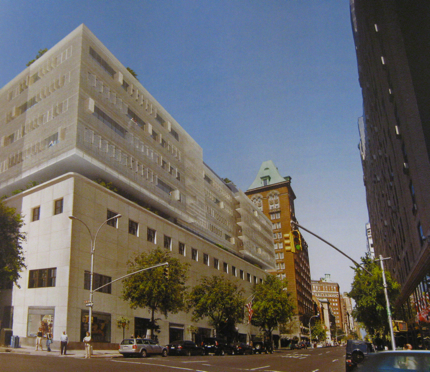
There is a familiar complaint, from Tom Wolfe on down to the blogosphere, that the fame of one’s architect—particularly in connection with a certain Upper East Side gallery building—entitles the developer to lighter treatment from the city’s Landmarks Preservation Commission. But even if one of the commissioners had not insisted on the contrary at a January 13 meeting on 980 Madison, the verdict the project received should, once again, affirm the commission’s refusal to play favorites.
“I just want to say, addressing some of the comments that have been showing up on blogs and such, that this doesn’t have anything to do with who the developer is, or who the architect is,” commissioner Margery Perlmutter said, referring to Aby Rosen and Norman Foster, the team behind the project. “It’s a good piece of architecture, and that should be encouraged in New York City.”
But beyond Perlmutter’s general approval of the project as it was presented, and commissioner Christopher Moore’s prurient endorsement—“I wouldn’t want to see a timid design,” he said. “If you’ve got a great bottom, you should have a great top.”—the commissioners roundly agreed that the proposal was too tall. Still.
Rosen’s team went out of their way to impress the commission, bringing tons of models and samples, including a full-scale mock-up of the aluminum sunscreens.
Matt Chaban
|
It has been a long slog for Rosen and Foster, who first presented plans to build atop the famed Parke-Bernet Building in 2006. The 22-story elliptical glass tower they sought to build atop the 5-story, full-block masonry building caused quite a stir, attracting famous supporters and detractors before being voted down by the commission in January 2007.
The team then returned last July with a five-story addition designed to match the proportions of the building below, which was panned by a number of locals who testified against it. Fewer stars turned up on that occasion, including Lord Norman, though Wolfe, who lives across the street from the proposed development, did make an appearance.
When the team returned last week, they presented essentially the same plan, except that the aluminum rods that comprised the addition’s sunscreen had been lightened from a terra-cotta color to one that Brandon Haw, director of Foster + Partners’ New York office, described as “champagne,” and a parapet on the top floor had been set back, as opposed to being flush with the street wall as originally proposed.
Every commissioner applauded the considerable thought and detailing that went into the design. “It’s very elegant, as we’ve seen before,” commissioner Stephen Byrns said. But, as most commissioners agreed, there was one major issue. “I think it has a real scale problem,” Byrnes added. The major challenge facing the commission was that they wanted further concessions from Rosen, who had been very patient thus far, at the same time they applauded his desire to restore the old gallery to its former glory.
Almost as dramatic as the addition to the parke-bernet building is the restoration work that will go into the existing building.
“The fact that this building has been so screwed up, with the addition of the third floor windows and the changing of the fourth and the awkward penthouse, that buys you a legitimate addition,” Byrnes continued. “The question is, how much of an addition?” The consensus seemed to be two stories, with possible setbacks from there, but the special Madison Avenue preservation district presents a very tight zoning envelope, as Rosen’s attorney pointed out.
"It’s the base we should be celebrating here," commissioner Roberta Smith said, referring to the original building, "and we shouldn’t even be calling it that. It’s not a base, it’s the main attraction. The edition needs to be lower."
“The question is, is it reconcilable with the landmarks law we are required to uphold as well as the precedents we set every week?” asked commission chair Robert Tierney. “I think this is achievable, but this is not yet it, and the issue remains one of scale.” Thereafter, the meeting adjourned, and Rosen held a half-hour meeting with his team in a conference room off the hearing room. When he finally exited, he seemed flustered. Asked about the future of the project, he said simply, “We’re studying that.”
Foster + Partners New York Office director Brandon haw presents his firm’s plans for 980 madison as commission Chair robert tierney (left) and commission counsel mark silberman look on.
foster + partners brought so many supplies to its presentation, one preservationist joked that it looked like a rock band was going to perform.